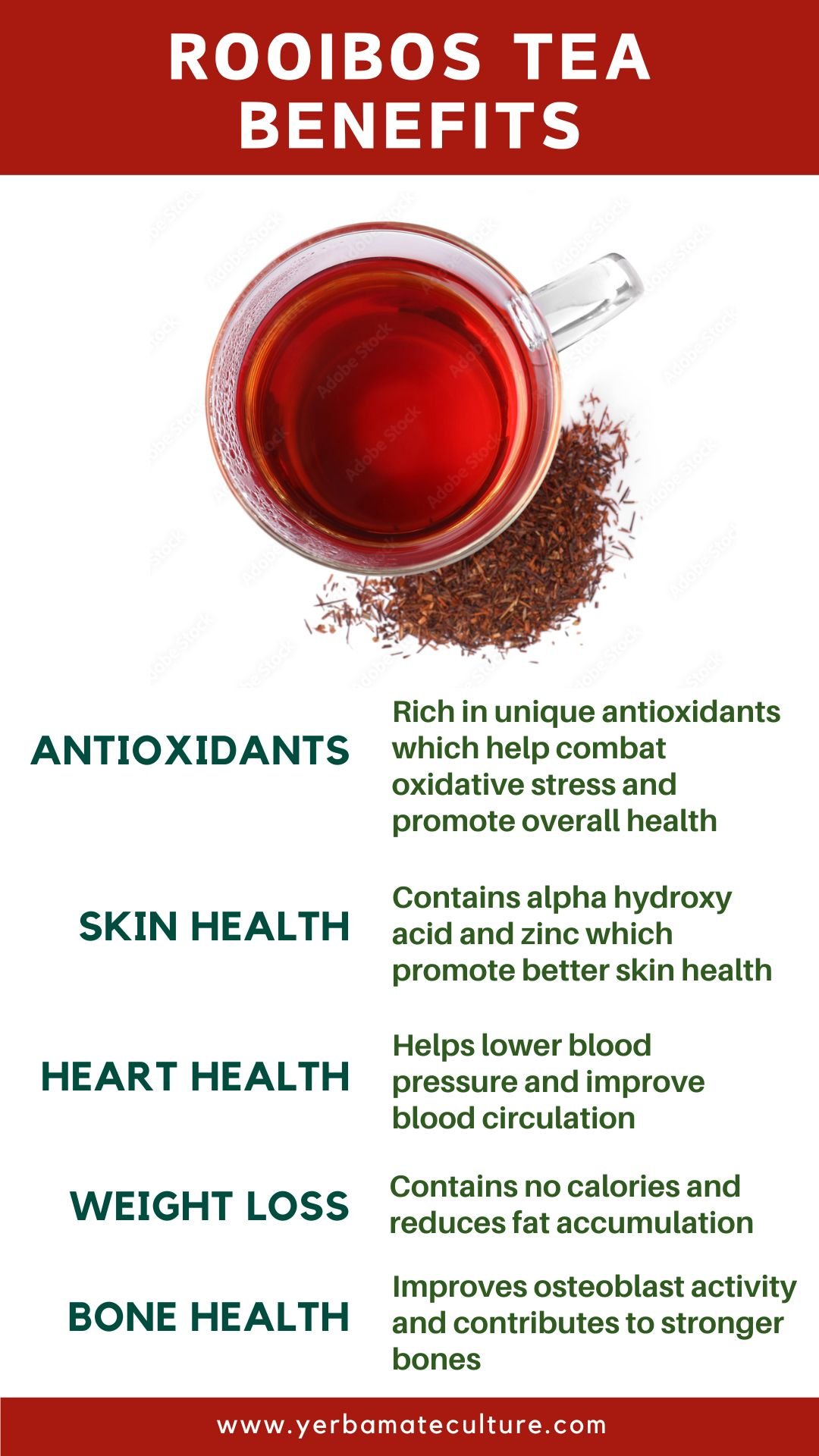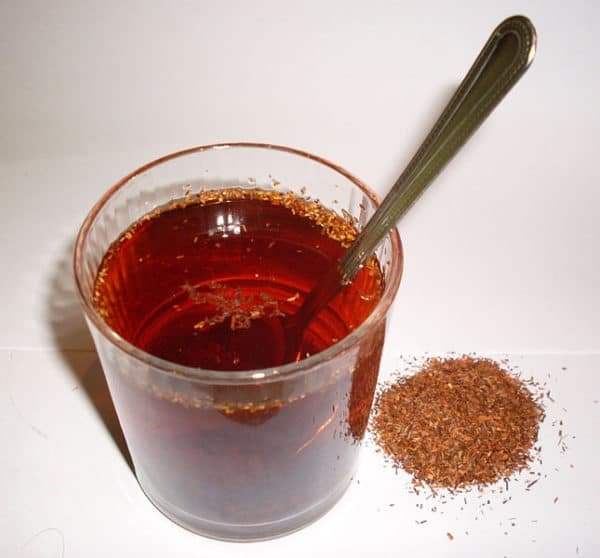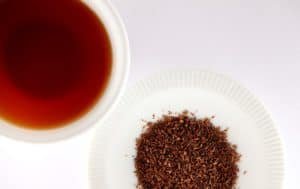Rooibos tea is one of my favorite herbal teas because it tastes delicious and has many health benefits.
In this guide, I’ll tell you all about the history and great healing powers of this amazing beverage. In addition, I will cover the possible side effects of rooibos tea.
Rooibos tea has no caffeine and no calories. Instead, it contains a lot of antioxidants and a variety of beneficial minerals. That’s why this South African beverage is so healthy and I can sincerely recommend it for everyone.

History of Rooibos Tea
The indigenous Khoisan people of the Clanwilliam region in South Africa have been using rooibos leaves for thousands of years. To the Europeans, the first reports of rooibos came from Carl Thunberg, a Swedish botanist, who traveled to South Africa in 1772. He noticed that the Khoisan people climbed to the mountains and gathered leaves from wild rooibos bush.
After foraging for the leaves, the Khoisan would roll them into bags and bring them down from the mountains. Then the leaves were chopped smaller with axes, battered with hammers, and dried in the sun.
The Khoisan used the rooibos leaves to make herbal remedies for many different conditions.

In the 18th century, the Dutch settlers started drinking rooibos tea, mainly because it was cheaper than black tea imported from Europe. A Russian immigrant named Benjamin Ginsberg became fascinated with rooibos tea during the early 20th century. He is often called the father of commercial rooibos tea, and he was the first one to cure rooibos leaves by fermenting them in barrels.
Rooibos production started to increase in the 1930s when Dr. Pieter Le Fras Nortier developed a method for germinating rooibos seeds, which allowed larger-scale cultivation of the plant. Dr. Nortier also researched the medicinal properties of rooibos, and his work was continued by Dr. Annetjie Theron who discovered that rooibos helped with her baby’s colic.
Today, it’s well-known that rooibos has many health benefits, and its global demand is high and increasing rapidly. However, it’s cultivated only in South Africa. The attempts to grow it in other countries have failed.
Matula tea ingredients also include rooibos leaves. This South African herbal drink is often used to treat H. pylori bacteria and many other digestive issues.
What is Red Rooibos Tea?
Rooibos (Aspalathus linearis) means ‘red bush’ and it has needle-like green leaves and yellow flowers.
Red rooibos tea is brewed from fermented rooibos leaves. The fermenting process gives the leaves a reddish-brown color and a sweeter flavor.

Tea made from fermented rooibos leaves tastes earthy, smooth, and a bit sweet. It contains high levels of antioxidants and is considered very healthy.
Green Rooibos Tea – The Unfermented Rooibos
Green rooibos tea is brewed from unfermented rooibos leaves. The leaves are harvested early in the morning and dried quickly to avoid fermentation.
Thus, the leaves retain their green color and have an even higher amount of antioxidants compared to red rooibos tea. After drying, the leaves are cooled and then packaged.
The taste of green rooibos tea is more grassy and mild compared to red rooibos.
How to Brew Rooibos Tea
You can brew rooibos tea by boiling water and steeping a tea bag or loose leaf rooibos tea for at least 4 minutes. You can let it steep for up to 10 minutes to make a stronger tea.
But first, you need to buy some of this tea. So read my guide with the best rooibos tea and start brewing!
It’s common to add some milk and honey or sugar to enhance the flavor of rooibos tea. You can also make an excellent iced tea with rooibos.
Check out this video and learn how to make delicious honey cinnamon rooibos tea:
5 Amazing Rooibos Tea Benefits
Rooibos tea has many health benefits that have been proven by research. It contains powerful antioxidants and important minerals that can make us healthier and help with numerous illnesses.
Here are the most important health benefits of rooibos tea:
1. Loaded with Antioxidants
Rooibos tea is highly valued for its rich antioxidant content. This herbal tea contains a unique set of antioxidants, including aspalathin and nothofagin, which are rare in other plant foods. These antioxidants are known for their potential to combat oxidative stress and inflammation, contributing to overall health.
Also rich in polyphenols, including flavonoids and phenolic acids, rooibos tea has a remarkable overall antioxidant profile. This makes it not only a refreshing beverage but also a beneficial one in terms of supporting the body’s defense against free radical damage, preventing cancer, and promoting overall wellness.
2. May Improve Skin Health and Appearance
Rooibos tea contains alpha hydroxy acid and zinc which are good for skin health.
A study conducted at Nelson Mandela Metropolitan University in South Africa found that rooibos tea helps with restoring the function of aged cells and thus. This tea can actually reduce wrinkles and make your skin look younger!
3. Helps Lower Cholesterol and Improve Blood Pressure
Quercetin, the earlier mentioned flavonoid, has anti-inflammatory properties that promote an increase in good cholesterol (HDL) and prevent bad cholesterol (LDL) from attaching to arteries and blood vessels.
Rooibos tea also helps with inhibiting an angiotensin-converting enzyme which causes an increase in blood pressure. Keeping blood pressure at optimal levels helps with mitigating cardiovascular diseases and atherosclerosis.
Drink rooibos tea daily to help your blood pressure stay at optimal levels.
4. May Help with Weight Management
There are no calories in rooibos tea and it also increases your body’s leptin levels, which makes you feel fuller for a longer time. It also reduces the formation of new fat cells and promotes faster fat metabolism.
This makes rooibos tea one of the best teas for losing weight.
5. Supports Healthier Bones
The polyphenols in rooibos tea improve osteoblast activity, which supports the development of healthy bones.
In addition, a study conducted in 2014, shows that the flavonoids luteolin and orientin enhance the mineral content of bone cells.
Bamboo leaf tea is another great herbal tea for improving bone health.
Unverified Benefits
Rooibos tea may have even more benefits, but more research is needed to verify them.
Can Help with Controlling and Preventing Diabetes
Rooibos tea may help with keeping blood sugar levels steady because it contains aspalathin. This antioxidant may help balance blood sugar levels and improve insulin resistance which can be particularly beneficial for type 2 diabetes.
Also, aspalathin and nothofagin, both found in rooibos tea, can lower the inflammation of blood vessels and arteries. This can be a major benefit for diabetics because they tend to suffer from chronic low-level inflammation that affects their insulin system.
May Reduce Allergies
There are two flavonoids, chrysoeriol, and quercetin, found in rooibos tea, that are good for treating allergies.
Chrysoeriol has antioxidant and anti-inflammatory properties. According to research, it relieves wheezing and coughing associated with allergies and asthma.
Quercetin blocks the release of histamine, so it works as a natural anti-histamine and prevents allergic symptoms from triggering.
Can Promote Better Sleep
I have a habit of drinking rooibos tea before going to sleep.
It lowers your cortisol levels, which promotes better sleep. Cortisol is a stress hormone and high levels are not good for sleep. In addition, the magnesium and potassium in rooibos calm your nervous system and support melatonin production.
If you are having problems with insomnia and relaxation, check out my article about the best herbal teas for improving sleep.
May Aid Digestion and Alleviate Stomach Pain
There are several antispasmodic nutrients found in rooibos tea, which help with stomach pain. They have a relaxing effect on the digestion system and are capable of relieving stomach pain and cramps. In addition, the tannins in rooibos can reduce symptoms of diarrhea.
Potential Side Effects of Rooibos Tea
In general, rooibos tea is considered safe and it has no notable side effects.
However, there are a few things worth mentioning:
- Large doses of rooibos tea are not recommended for people with hormone-sensitive diseases (e.g. breast cancer) because it can increase the production of estrogen.
- The high amounts of antioxidants in rooibos tea could interfere with certain medications. If you are taking medications, it’s recommended to consult a physician to avoid any problems.
Rooibos Tea – It’s Healthy and Delicious!
I recommend that you watch this short video that does a great job of summarizing what rooibos tea is:
To sum it up, we can say that red rooibos tea is a healthy and tasty drink with an interesting history. In addition, there is also green rooibos tea which contains even more antioxidants.
Rooibos tea is safe to drink every day, even for small children. The only people who should be careful with drinking it, are people with certain diseases and/or medication.
Now that you know what red rooibos tea is, you probably want to try it out.
If you have any comments or questions, please post them below.



Wow, what an amazing plant! I have heard of rooibos but I have not tried it yet.
I will check out your link and try some for my allergies and the added benefit of magnesium. Do you think the rooibos teas at Starbucks are decent quality?
Good to hear that you liked my article Irma!
I also have allergies and rooibos helps me with that, so I can recommend it for you. I think Starbucks rooibos should be good quality, although I have not yet tried it myself. Here is more information related to it: https://sarooibos.co.za/uk-smitten-with-starbucks-new-smash-hit-rooibos-latte/
-Joonas
Fantastic article! Really informative and interesting. I also see this tea down at my local health food stall, but always go straight to the Green Tea section, however next time some of this will be going straight into my bag.
Also really liked your website. The selection of different youtube videos are great. Keep up the good work.
Colin
Hi Colin,
I’m happy to hear that you found my article interesting! I also like green tea, especially with mint. Rooibos is very different from green tea, so I am sure you will enjoy drinking it for a change.
I will definitely keep on posting more articles, and I will always include a Youtube video if there is one that fits the topic.
Cheers,
Joonas
Can you buy this tea in grocery stores?
Hi Lorna,
Yes, you can find rooibos tea bags in most groceries!
Regards,
Joonas
I love rooibus tea from Sri Lanka. After a disaster in the area, I actually emailed Sri Lanka. I am not a tea drinker but I found a box years ago in Big Lots. When I got home, the box said “herbal tea and how the bush people give it to pregnant women” Meh. One day I was so sick from a sinus infection, I’d drink anything warm. How delicious and healing. I see this tea in places like Home Goods and Ross. Not a fan of the big name brand in grocery stores.
Hi Myrna,
Thanks for your comment!
I didn’t know that they also produce rooibos tea in Sri Lanka. I thought it always comes from South Africa.
-Joonas